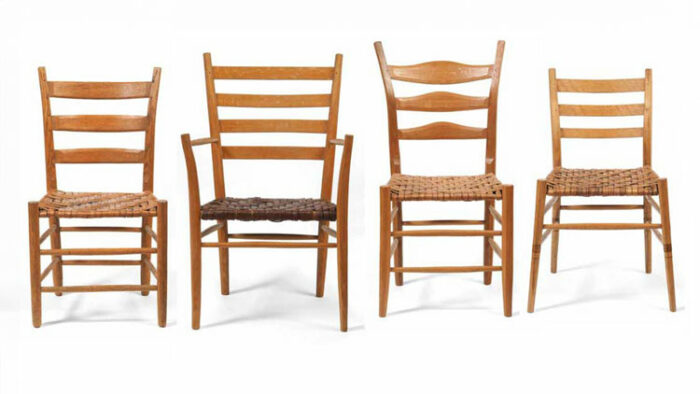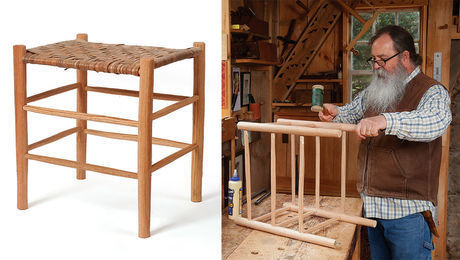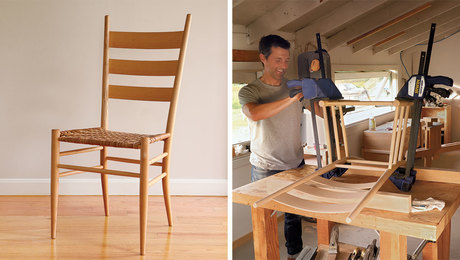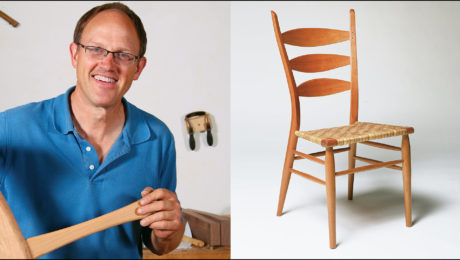Andy Glenn’s Ladderback Life – FineWoodworking
A variety of American ladderback
When I think of the ladderback, three American chair forms come to mind: early New England ladderbacks, the Shaker chair, and bent-back chairs of Appalachia. Early New England chairs were often boldly turned with finials upon the back posts, along with straight backs and a rush seat. Shaker chairs were refined and reduced in design, with thin, unembellished turnings and a cotton tape seat. Their lightness of form is still admired today, though the upright back reduces comfort. That uprightness is a challenge in the design. Too vertical, and users feel as if the chair is pushing them forward. But simply tilting the straight posts back to achieve some comfort makes the chair more likely to tip backward.
|
|
|
|
It’s the third form, the Appalachian ladderback chair, that resonated with me during my family’s time in the region. Whenever I close my eyes and think of a ladderback, it’s the contemporary form of Brian Boggs’s Berea chair that appears in my mind: turned, with three horizontal slats, box rungs that are pushed upward to give the chair a lighter look and feel, and a refined hickory bark seat. This chair is an example of taking a traditional form and then pushing it forward.
|
|
|
 |
 |
Focusing on the Appalachian chair
The Appalachian chair is too broad a tradition to be reduced to a few narrow design details. But an Appalachian chair often has a bent back post, little to no ornamentation, and a woven seat typically of hickory bark. Perhaps it’s the seat material of choice because there is an abundance of hickory to be found within the forests of the region.
These chairs are ideal for green woodworking. Their strength and resilience comes from the post-and-rung joinery. With green (or air-dried) materials, the posts are wetter and shrink as they dry. The rungs are dried below the ambient moisture content, either in a kiln or beside the woodstove or radiator, so the tenons swell once they’re added to the chair. The joints are a tight fit only made once, during assembly. There is no dry fit. That locking action, associated with green-wood chairmaking, is enough that some chairmakers do not use glue during assembly. I always use glue.
The hickory seat
A post-and-rung ladderback creates an ideal frame for a woven seat. A number of material options are available; Shaker tape, Danish cord, splints, flat reed, leather, and seagrass are all commonly used. I am partial to hickory bark, as it is both long-lasting and durable, while also being warm and inviting. The bark offers a comfortable seat that holds its shape.
 |
 |
 |
 |
| Harvesting hickory bark. After you’ve shaved away a 4- to 6-in.-wide section of the rough outer bark down the length of the log with a drawknife, you can begin harvesting the inner bark. With a utility knife, make as straight a cut as you can along the length of the log. Then go back and make a cut parallel to that one. You will not achieve perfectly straight and parallel cuts, but that’s OK. Starting at the end, peel the bark back and work your way down the length of the log. You’ll find the bark lifts off easier in some spots. Adjust your firmness as you feel it holding tighter in other sections. Be careful not to coil it too tightly, since it can mildew during storage. | |
The challenge is obtaining it. Hickory bark is available online, often with significant lead times. But there is nothing more rewarding than harvesting the bark that you use to weave the seat on a chair you built. It is harvested in the spring, when the bark is slipping. Slipping bark easily peels away from the trunk. It sticks to the tree the rest of the year.
After harvesting the bark, you can weave it directly into a chair. It works like leather when wet and dries firm and strong around a chair frame. You can also store it in coils in a dry place and soak it in water to regain its workability when you’re ready to weave it.
Tools and tree selection
Phil Vogel talks about the partnership between Berea College and its surrounding trees.
When I go out in the woods to harvest bark, I carry a bucket of supplies: drawknife, knife, sharpening/diamond paddles, cant hook (to roll larger trees), crosscut saw, tape measure/yardstick, and tarp (to cover the tools if it rains).
I’m not a dendrologist or a skilled cutter, and so I need to rely on a forester’s experience to find and drop the hickory trees. Recently Berea College forester Phil Vogel went out with me to walk the woods and knock over a few trees. There are only a couple of days to get the bark off a tree once it’s on the ground; after that, it starts to adhere again to the wood beneath.
The right part of the bark
Students learn to harvest bark for hickory-weaved seats
The bark usable for weaving is found just under the rough outer layer. After the outer bark is removed, the inner bast is cut into strips 1/2 in. to 2 in. wide, pulled off the log, and rolled into coils.
The larger the tree, the thicker the bark. Bark from larger trees is often too thick to use in a chair. But thicker bark can be trimmed thinner or else split in two, with the inner layer (the one closest to the cambium) being of higher quality.
 |
 |
| Fine-tuning the bark. Once you’re back in the shop, you can address the thickness and width of the bark you harvested. If you chose to save time in the woods by cutting wide strips from the log, you can cut the bark to weaving width by running it through a leather-strap cutter. Glenn screws his cutter to a piece of pine, which he then clamps to his bench. You can adjust the cutter to the width you desire. One way to get the bark thinner is to split it. Use a knife to score the end and start the split. Then use your hands to split the bark down its length. | |
You can shave bark to thickness (around 1/8 in. thick is ideal) at the shave horse with a spokeshave. Or you can pull it apart by hand. This method of splitting thick bark may yield a second coil, which is the one I prefer.
Stripping the bar
Andy Glenn harvests bark in the forest surrounding Berea College.
Once the tree is on the ground, I shave off the outer layer of bark. After I clear a 4- to 6-in.-wide section the full length of the log, I use a knife to score a deep line along the length, followed by another cut at the desired width. It’s difficult to keep an even width, and the line usually wanders 1/8 in. or so. I’m not concerned by minor variations; they feel and look right in a handmade chair. At times, peeling requires a firm hand to lift the bark safely off the tree. I loosely coil the bark while peeling it and then store the freshly harvested bark in a cool, dry place with air movement or a fan.
Once I get a full-length section with the outer bark shaved off and then the inner bark cut and peeled away, I keep turning the log and repeating the process until I’ve gone all the way around the log and removed all the bark.
An alternate processing method
I sometimes skip cutting the strips to final width in the forest. I’ll peel pieces 3 to 4 in. wide from the log, then go back to the shop and run the pliable bark through a leather-strap cutter. This provides improved uniformity (though the strips are still not perfectly sized). I like this method because it’s easier than crouching and slicing all the coils on the forest floor. You can purchase strip cutters online starting at $35. With the strips cut to width, you’re ready to weave the hickory into a chair seat.
—Andrew D. Glenn is a furniture maker, teacher, and author in Waldoboro, Maine.
Sign up for eletters today and get the latest techniques and how-to from Fine Woodworking, plus special offers.
Download FREE PDF
when you enter your email address below.















